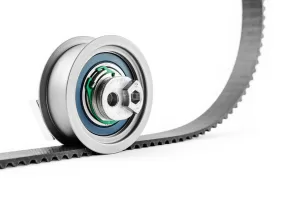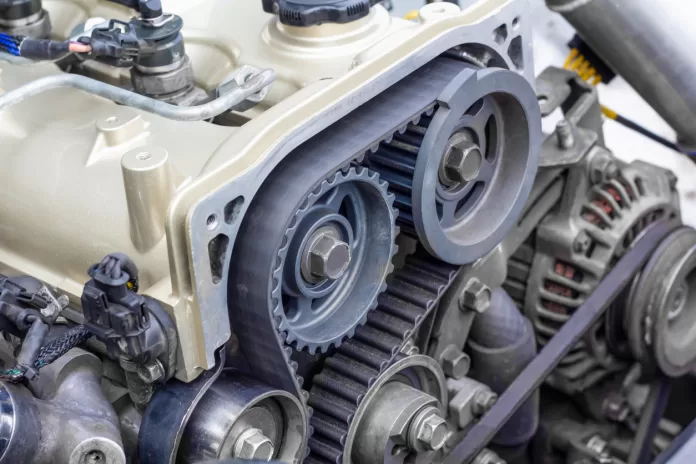Timing belts and chains may not be the first thing that comes to mind when you think of car maintenance. However, they are important components in your vehicle’s engine. They synchronize the rotation of the crankshaft and camshaft(s), ensuring that engine valves open and close at the correct times during each cylinder’s intake and exhaust strokes. Basically, if your timing belt or chain fails, your engine can suffer severe damage.
Before knowing when to change them, it’s good to understand the difference between a timing belt and a timing chain:

Timing Belt: Usually made of rubber, timing belts are quieter and lighter than chains. They have nylon teeth that help them grip and sync with other engine parts accurately. They are commonly found in many modern vehicles and are normally found inside the engine covered by a timing belt cover controlling the opening and closing of engine valves.
Timing Chain: A metal chain that serves the same purpose as a timing belt, but is generally more robust and designed to last longer than belts. Nonetheless, they can still stretch or wear out over time and may need adjustments or replacement. They are often used in high-performance vehicles and are usually located inside the engine as well, driven by the crankshaft.
When to Change Your Timing Belt or Chain.
Whether your vehicle has a belt or chain, certain warning signs suggest it’s time to consider a replacement. Here is a comprehensive guide to help you decipher how to care for this vital component of your car:
1. Follow Manufacturer Recommendations
The safest bet for determining when to change your timing belt or chain is to refer to your vehicle’s owner manual. Most manufacturers provide a recommended interval, typically measured in miles or years. This will give you a clear guideline on when to replace your timing belt or chain.
Timing Belts: Generally, timing belts should be replaced every 60,000 to 100,000 miles or every 5 to 7 years, depending on driving conditions and the manufacturer’s recommendations.
Timing Chains: In contrast, timing chains are designed to last the lifetime of the engine and usually do not require replacement unless there are signs of wear. However, some chains may need replacement every 80,000 to 120,000 miles due to a lack of maintenance or faulty tensioners.
2. Listen for Noise
If you hear a rattling sound coming from your engine, or if the engine sounds different than usual, it could be a sign that your timing chain or belt is failing. Timing belts might give you the first signals through unusual noises, while timing chains can show issues like a ticking sound if there is a problem.
3. Misfiring Engine
Your vehicle’s engine misfiring or has decreased power can be an indicator of timing issues. This might suggest that the timing belt or chain isn’t aligning components as it should.
4. Check for Oil Leaks
A timing belt is often housed within an engine cover, and oil leaks may occur from wear and tear of the seals. If you notice oil pooling in the vehicle’s vicinity, inspect the timing belt area, as this could indicate another issue. It’s important to get your vehicle inspected promptly, as oil can cause a timing belt to deteriorate faster.
5. Inspect for Wear and Tear
If you can access your timing belt (generally more accessible on vehicles with belts than those with chains), inspect it for cracks, fraying, or wear. Any visible damage means it’s time for a replacement. Timing chains may require more in-depth inspection, including checking the tensioner and guides for proper function.
6. Consider Driving Conditions
If you often drive in extreme conditions—such as heavy traffic, high temperatures, or severe cold—your timing belt or chain may wear out faster. In such cases, you might need to replace it more frequently than the standard recommendations.
7. Look for Engine Warning Lights
Modern vehicles are equipped with engine management systems that can alert you if there’s an issue, including with the timing belt or chain. If your “Check Engine” light comes on, it’s essential to have your vehicle inspected as it may signify a timing issue among others.
The Importance of Replacement
Failing to replace a timing belt or chain when due can lead to severe engine damage, which can be both costly and time-consuming to repair. If the belt breaks, it can cause the pistons and valves to collide, causing the valves to curve, damaged pistons, or complete engine failure.
However, changing your timing belt or chain at the right time can be a significant factor in maintaining your vehicle’s health. If in doubt, consult with a qualified mechanic who can assess your vehicle and provide the right advice for your timing belt or chain maintenance.
By Uche Maxwel




